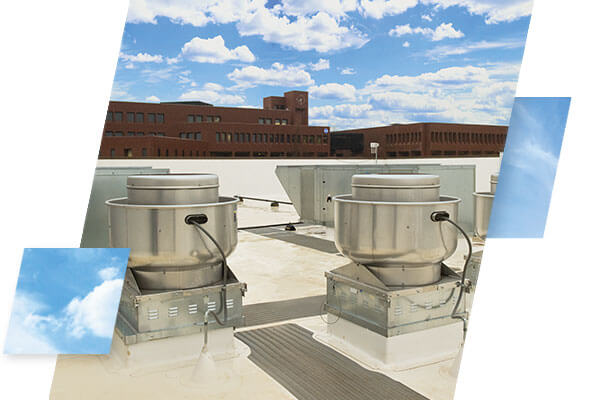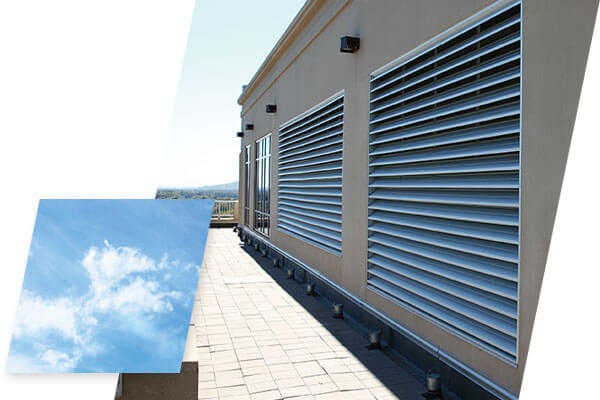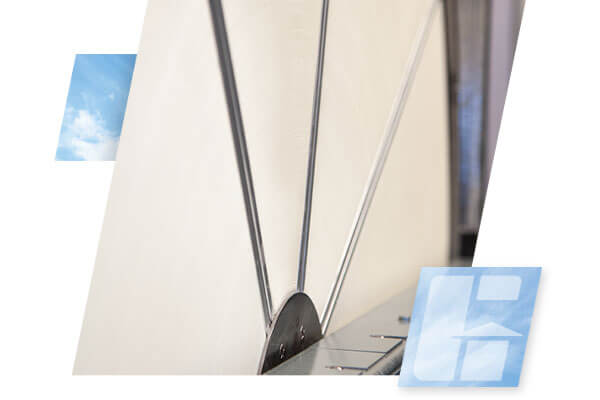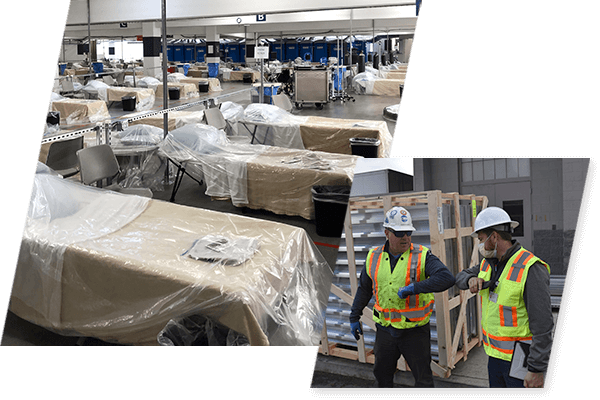Our Commitment
to Improving
Indoor Air Quality
Greenheck's comprehensive line of air movement, control and conditioning equipment and engineered ventilation systems play a critical role in delivering the essentials of healthy indoor air.


The introduction of fresh, outside air into a building helps disperse and dilute indoor air contaminants including VOLATILE ORGANIC COMPOUNDS (VOCs), CO2, pollutants and viruses, spaces of stale, oxygen-depleted air and airborne pathogens. Greenheck's air movement products include supply and exhaust fans, lab exhaust fans, blowers, ceiling exhaust fans, HVLS fans and circulators that efficiently work to improve indoor comfort, health, safety, and productivity.
LEARN MOREAir distribution refers to how air moves within a space as a function of air rotations and air velocity. Proper air distribution reduces high concentrations of pathogens from forming in a space. Greenheck grilles, registers, diffusers and air terminal units provide air distribution within an indoor space. Air distribution also aids in destratification (mixing hot air that rises with cooler air beneath) to help improve occupant comfort and reduce energy costs. Greenheck HIGH VOLUME LOW SPEED (HVLS) fans are ideal for comfort cooling and destratification.
LEARN MORE

Air control products like dampers, louvers and gravity ventilators direct and regulate air movement within a ventilation system. Greenheck offers the most UL certified dampers and the largest selection of AIR MOVEMENT AND CONTROL ASSOCIATION (AMCA) licensed dampers in the industry. Damper applications include fire and smoke control in life safety systems to airflow control in commercial HVAC and industrial process systems. Louver and gravity ventilators provide the passage of fresh air through exterior building openings while inhibiting the entrance of rain or other elements.
LEARN MOREStudies show that maintaining relative humidity between 40%-60% will reduce potential for airborne viral transmission. Greenheck's energy-efficient air conditioning products ensure optimal temperatures and humidity levels that keep occupants comfortable and employees productive. Utilizing energy recovery with a DEDICATED OUTDOOR AIR SYSTEM (DOAS) will help reduce the cost to humidify or dehumidify ventilation air.
LEARN MORE

Energy recovery is the process of transferring energy between the conditioned return air from the indoor space and the fresh, outdoor air, which imposes the load on mechanical equipment. Fresh, outdoor air enters the energy unit where an energy recovery wheel or core treats the air before entering the heating and cooling equipment. The benefits include improved indoor humidity levels, reduced energy costs and lower first cost for air conditioning (due to a reduction in outdoor air load).
LEARN MOREHVAC systems typically utilize filters with a MINIMUM EFFICIENCY REPORTING VALUE (MERV) rating of 8. MERV 8 filters are effective at capturing large particles such as dust and pollen but are not effective at capturing smaller pathogens. Filters with a MERV 13 rating or higher can capture approximately 85% of airborne respiratory particles and are recommended to help capture COVID-19 and other pathogens. Greenheck products can be specified with higher filtration options.
LEARN MORE
For more specific information on the importance and implications of clean air and how well-designed ventilation can help mitigate viral transfer, please visit our FAQ page here.

Since the COVID-19 pandemic, ventilating fresh outdoor air into buildings has taken on even greater importance as a way to help mitigate viral transfer indoors. As a ventilation manufacturer for more than 70 years, our sole focus has always been on improving indoor air quality in commercial, institutional, and industrial buildings.
Our commitment to indoor air quality continues through the engineering and manufacturing of our high-quality ventilation products, with an increased focus on decreasing the risk of disease transmission through proper design and operation of HVAC systems. While there is no single way to eliminate viral transfer, we do know that ventilation, humidity control, proper filtration, and air circulation can help mitigate its spread.
Throughout the pandemic, we worked closely with engineers, contractors, and facility managers to manufacture and expedite delivery of our equipment to assist in renovating essential facilities to meet COVID-19 concerns.
We are proud to have provided critical contributions across the country including:
- Providing exhaust and supply air systems to convert a Reno, Nevada hospital parking garage into a COVID isolation ward.
- Supplying Vektor® and FumeJet® lab exhaust equipment for new patient isolation rooms in California and Virginia hospitals.
- Manufacturing a vital louver product in one day and airfreighting it to a south Florida hospital that converted patient space into a COVID-19 ICU where airflow is critically important.
- Manufacturing a damper in less than 24 hours for a medical supply company that needed to retrofit a facility for hand sanitizer in response to COVID-19.
- Supporting ongoing operations in digital warehouses via Greenheck's equipment and services.

Read more on how Greenheck has supported facilities throughout the pandemic.
Indoor air quality -
it's what we do at Greenheck
Greenheck provides the industry's most comprehensive line of 1000+ ventilation products to create healthy, safe and comfortable environments. From hospitals to schools, warehouses and more, our reliable, energy-efficient air movement, conditioning and control products can help you address any application, any challenge. Indoor air quality - it's what we do at Greenheck
What role does outdoor air play in virus prevention?
The introduction of outdoor air helps disperse and dilute indoor contaminants including virus particles. Increasing the amount of outdoor air coming in through the HVAC system helps improve indoor air quality and reduce the concentration of aerosol pathogens in the air.
What are the benefits of clean air within indoor spaces?
Clean air within indoor spaces helps improve indoor air quality, reducing concentration of VOLATILE ORGANIC COMPOUNDS (VOCs) and other pollutants and minimizing the risk associated with airborne pathogens. In fact, according to the ENVIRONMENTAL PROTECTION AGENCY (EPA), the concentration of some pollutants is often 2 to 5 times higher indoors than outdoors. With the average American spending approximately 90% of their time indoors, indoor air quality is extremely important to everyone's health and comfort.
How do viruses such as COVID-19 spread within indoor spaces?
COVID-19 can spread through airborne particles in indoor environments. According to a STATEMENT, released in April 2021 by the AMERICAN SOCIETY OF HEATING, REFRIGERATING AND AIR-CONDITIONING ENGINEERS (ASHRAE) Epidemic Taskforce: Airborne transmission of SARS-CoV-2 is significant and should be controlled. Changes to building operations, including the operation of heating, ventilating, and air-conditioning systems, can reduce airborne exposures. In light of this, it is important to make sure proper HVAC systems are installed and operating safely within your indoor spaces. ASHRAE also recommends performing needed HEATING, VENTILATING AND AIR CONDITIONING (HVAC) system maintenance, including filter changes, and to run HVAC equipment prior to re-occupancy.
How does increased air ventilation prevent the transmission and spread of viruses such as COVID-19?
Increased ventilation can lower the concentrations of indoor air contaminants, including viruses, by circulating outdoor air to disperse and dilute any potential air contaminants. ASHRAE Standard 62.1 specifies minimum ventilation rates and other measures intended to provide indoor air quality that is acceptable to human occupants and that minimizes adverse health effects.
For example, ASHRAE recommends that homes receive 0.35 air changes per hour, but not less than 15 cubic feet of air per minute (cfm) per person, as the minimum ventilation rates in residential buildings in order to provide IAQ that is acceptable to human occupants and minimizes adverse health effects.
For commercial buildings like offices or schools, ASHRAE 62.1 does not give a fixed number as airflow rates are calculated based on the size of a room, its use, and the number of people occupying the space. Air exchanges can range from 2 to 8 exchanges per hour based on these factors depending upon the type of commercial building. In hospitals and other spaces that deal with viruses and other airborne infections, higher ventilation rates are recommended; the CDC recommends 6 to 12 air changes per hour for airborne infection isolation rooms.
What products can help prevent the transmission of COVID-19 and other airborne diseases?
A well-designed air distribution system can help improve indoor air quality and reduce energy costs in all types of buildings by efficiently adding and circulating clean air and removing air contaminants such as virus particles, fumes, or smoke.
Greenheck is a single source manufacturer of all of the ventilation equipment needed to bring fresh air into a space and effectively circulate the air while maintaining comfort and energy efficiency. Read on to learn more about ventilation equipment for specific building applications such as schools/universities, health care facilities and warehouses/distribution centers.
To determine which products are needed for your building project or indoor space, connect with your local GREENHECK REPRESENTATIVE.
Do electronic air cleaning devices, such as UV Light and needlepoint bipolar ionization, prevent COVID-19?
In addition to increased ventilation rates and filtration efficiency, electronic air cleaners are additive technologies to help mitigate the spread of aerosol respiratory droplets in indoor environments. Since the onset of COVID-19, the market has focused on two particular types of electronic air cleaners:
- ULTRAVIOLET GERMICIDAL IRRADIATION (UVGI) uses short-wavelength ultraviolet light to kill or inactivate microorganisms and can be installed near ceilings or within HVAC equipment.
- Bipolar ionization and NEEDLEPOINT BIPOLAR IONIZATION (NPBI®) produce a stream of ions that attract all particles including viral pathogens to cling together, improving the effectiveness of filter systems.
Electronic air cleaning devices can supplement HVAC systems to clean indoor air and mitigate the spread of airborne pathogens in recirculating air systems. Studies regarding the application of BPI and NBPI to mitigate the risk of pathogens such as SARS-CoV-2 are ongoing. UVGI and BPI/NBPI manufacturer recommendations should be followed.
How do I know when it is time to replace an HVAC system?
The average life expectancy of a commercial HVAC system is 15 to 20 years; however, several factors can determine whether that lifetime is shorter or longer. Preventative maintenance including changing filters, cleaning air ducts, and replacing worn out parts can extend the life of the equipment. It is also recommended that the system is inspected annually by a licensed contractor.
How does air ventilation impact performance within schools and universities?
A well-designed HVAC system can provide comfort and productivity within schools and universities while ensuring and enhancing health and safety. According to the ENVIRONMENTAL PROTECTION AGENCY (EPA), student performance is affected by indoor environmental conditions. While ventilation rates in classrooms often fail to meet minimum standards, improved classroom ventilation rates are also associated with improvements in student performance. According to the Berkeley National Laboratory's study on VENTILATION AND SCHOOL PERFORMANCE, intervention studies reported statistically significant improvements in performance with increased ventilation rates.
What products can be installed in schools/universities to help create healthy, safe, and comfortable environments for students and educators?
Greenheck's complete line of VENTILATION PRODUCTS FOR SCHOOLS help create a safe, comfortable, and productive environment for students and staff. From classrooms to bathrooms, gymnasiums to laboratories, auditoriums, and kitchens, Greenheck makes it easy to specify integrated systems that provide quick cost-saving installation, energy efficiency and quiet operation. Our products ensure IAQ fundamentals are achieved:
- Ventilation: Introducing outdoor air into a building is critical to ensure proper INDOOR AIR QUALITY (IAQ) in the space. Our rooftop ventilators condition and deliver 100% outside air or mixtures of outdoor air and return air to a building.
- Filtration: MERV 13 filters are the recommended minimum and MERV 14 is preferred per the American Society of Heating, Refrigerating and Air-Conditioning Engineers (ASHRAE) Filtration and Disinfection Guidance. In order to meet this guideline, we have added higher filtration options to various product lines.
- Humidification: Classroom design guidelines for a healthy space are between 40-60% relative humidity, which may reduce potential for airborne viral transmission. Our pre-engineered DEDICATED OUTDOOR AIR SYSTEMS (DOAS) deliver fully conditioned (heated, cooled, dehumidified) outdoor air at the precise level needed for your application.
- Air Distribution: Air movement is critical to produce the correct number of air rotations per hour to ensure dilution of contaminated air and mixing of fresh air. Our HIGH VOLUME LOW SPEED (HVLS) fans help meet proper air circulation requirements and provide energy-saving comfort cooling in the summer and air destratification in the winter.
Learn more about school ventilation by listening to our recent school IAQ PODCAST and referencing our education facility PROJECT PROFILES.
How does indoor air quality impact patient recovery in hospitals?
Cleanliness in hospitals is essential to patient recovery and that includes clean air. Poor indoor air quality can cause an increase in air contaminants and the spread of contagious diseases. To prevent new illnesses and the worsening of current symptoms in patients, it is critical to have proper HVAC systems installed within health care facilities.
According to the AMERICAN SOCIETY OF HEATING, REFRIGERATING AND AIR-CONDITIONING ENGINEERS (ASHRAE), ventilation rates should be increased and maintained 24/7 especially in buildings where known infections exist or are known to have occurred. The minimum ventilation rates during occupied periods should at least meet the recommendations of ASHRAE 62.1. The maximum amount of outside air can be as high as 100% depending on outdoor air conditions (temperature, humidity, pollution content), indoor conditions trying to be maintained (temperature and humidity), and the capacity of the HVAC system to condition (filter, cool and dehumidify) the outside air or outside air/return air mixture to conditions that will maintain the desired indoor conditions. Applying a combination of increased filter efficiency and increased ventilation rates may be the best way to achieve better indoor air quality and help dilute COVID-19 or other infectious aerosol concentrations indoors.
Another consideration for hospital ventilation is maintaining proper room pressurization. According to the AMERICAN SOCIETY OF HEALTHCARE ENGINEERS (ASHE), certain rooms within a health care building should be positively or negatively pressurized with respect to surrounding areas. Positively pressurized rooms are usually designed to protect a patient, clean supplies, or equipment within the room. Negative pressure is used to contain airborne contaminants within a room.
What products can be installed to improve IAQ and protect the individuals and the life-saving equipment/technologies used inside health care facilities?
With an increased focus on IAQ and energy efficiency, today's hospital ventilation needs are more dynamic and demanding than ever. To meet the complex and interrelated demands throughout a medical facility, you must equip for a wide variety of critical, specialized applications—public areas, offices, surgery suites, patient rooms, laboratories, kitchen, and cafeteria. Only an integrated HVAC system can provide the reliability and performance a hospital requires. Greenheck's complete line of ventilation equipment for health care facilities helps create safe, comfortable environments for patients and staff throughout the facility. Greenheck products are designed to work together, effectively, with energy efficiency and quiet operation.
Read more about Greenheck products at work in a health care environment in our recent health care facility PROJECT PROFILE.
How are air quality and ventilation important in warehouse facilities?
It is important to ensure proper indoor air quality in warehouse facilities as it can impact warehouse operations, employee well-being and safety, and the integrity of the products being warehoused.
A well-designed HVAC system can help remove pollutants caused by material handling equipment, such as forklift trucks, as well as warehouse machinery and delivery trucks. Failure to remove these gases and other pollutants place employees at risk for respiratory problems, congestion, and allergies. Removal of these pollutants will also significantly reduce the spread of contagious airborne diseases.
In addition, maintaining proper ventilation can improve safety conditions within the warehouse by reducing unhealthy air to keep workers alert and able to function at peak levels. Proper air circulation also helps maintain dry floors and surfaces to prevent accidents such as slips and falls.
What products can be installed in warehouses and distribution centers to improve indoor air quality and provide for the safety and comfort of workers?
Greenheck delivers all of the products needed for a well-integrated, multifaceted warehouse ventilation system for any application.
- SUMMER VENTILATION: Greenheck's industry leading supply fans, exhaust fans, louvers and dampers provide a complete solution for efficiently ventilating any warehouse or distribution center.
- SPACE HEATING: Model DGX direct gas-fired make-up air units provide cost effective, highly efficient heating by utilizing 100% outside air and 80/20 recirculating configurations to fit the needs of various distribution center designs.
- AIR DISTRIBUTION: HLVS fans are ideal for destratification, comfort cooling and condensation prevention in large industrial spaces.
- SMOKE EXHAUST: A variety of high-temperature exhaust fans with UL Power Ventilator for Smoke Control listings, and various louver and damper models, are available to meet smoke exhaust application requirements.
Read more about warehouse ventilation in our recent BLOG POST.
Have questions or just want to learn more?
